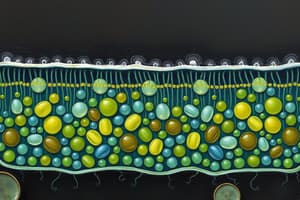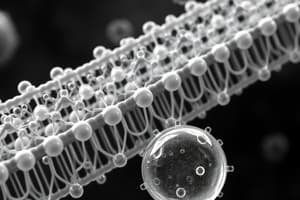Podcast
Questions and Answers
Which of these is NOT a type of permeability?
Which of these is NOT a type of permeability?
- Selectively Permeable
- Semi-Permeable (correct)
- Non-Permeable
- Permeable
A tiger is an example of a uni-cellular organism.
A tiger is an example of a uni-cellular organism.
False (B)
What is the function of the cell membrane?
What is the function of the cell membrane?
The cell membrane controls what enters and exits the cell.
The ______ is the powerhouse of the cell and produces energy through cellular respiration.
The ______ is the powerhouse of the cell and produces energy through cellular respiration.
Match the following organ systems with their primary functions:
Match the following organ systems with their primary functions:
Which of the following is an example of diffusion?
Which of the following is an example of diffusion?
The ______ is the gel-like substance that supports organelles and transports materials within the cell.
The ______ is the gel-like substance that supports organelles and transports materials within the cell.
Osmosis is the movement of any substance through a selectively permeable membrane.
Osmosis is the movement of any substance through a selectively permeable membrane.
Flashcards
Cell
Cell
A basic unit of life that carries out all functions of life.
Tissue
Tissue
Layers of cells that perform specific tasks.
Organ
Organ
A collection of tissues that work together to perform a specific function.
System
System
Signup and view all the flashcards
Diffusion
Diffusion
Signup and view all the flashcards
Osmosis
Osmosis
Signup and view all the flashcards
Selectively Permeable
Selectively Permeable
Signup and view all the flashcards
Mitochondria
Mitochondria
Signup and view all the flashcards
Study Notes
Cell Structure and Function
- Cell: Basic unit of life, performing all life functions. Examples include blood cells.
- Organ: Group of tissues working together for a specific function. For instance, the heart.
- Tissue: Layers of specialized cells, performing specific tasks. Example, connective tissue.
- System: Collection of cells, tissues, and organs, working together for a function. Example: the digestive system.
- Multi-cellular Organism: Made of many cells. Example: a tiger.
- Uni-cellular Organism: Made of a single cell. Example: an amoeba.
Permeability
- Selectively Permeable: Allows some materials to pass through. Example: a towel allows water but not larger particles to pass.
- Permeable: Allows all materials to pass through. Example: water passing through a sponge.
- Non-Permeable: No materials pass through. Example: steel.
Cellular Transport
- Diffusion: Movement of particles from high to low concentration. Example: perfume spreading in a room.
- Osmosis: Movement of water through a selectively permeable membrane. Example: water moving into a plant cell.
Cell Components
- Cell Membrane: Outer layer controlling what enters and leaves the cell.
- Cytoplasm: Gel-like substance supporting organelles and transporting materials.
- Nucleus: Controls cell activities, contains DNA.
- Vacuole: Stores water, nutrients, and waste.
- Mitochondria: Powerhouse of the cell, producing energy through cellular respiration.
- Chloroplast: Found in plant cells, converts light to chemical energy (photosynthesis).
- Cell Wall: Found in plant cells, providing support and protection.
Microscope Parts
- Eyepiece: Lens for viewing the sample.
- Objective Lenses: Different magnifications (4x, 10x, 40x).
- Stage: Platform to place the slide.
- Coarse/Fine Adjustment Knobs: Focusing the image (coarse for low power, fine for high power).
- Illuminator/Light Source: Provides light for viewing.
- Stage Clips: Holds the slide in place.
Organ Systems and Functions
- Digestive System: Breaks down food into absorbable nutrients.
- Respiratory System: Obtains oxygen and removes carbon dioxide.
- Circulatory System: Transports oxygen, nutrients, hormones, and removes waste.
- Excretory System: Removes waste from the body (e.g., kidneys remove urine).
- Nervous System: Controls/coordinates body responses to stimuli.
- Muscular System: Allows movement through muscle contractions.
Plant vs. Animal Cells
- Similarities: Both contain a nucleus, cytoplasm, cell membrane, mitochondria, ribosomes, and endoplasmic reticulum.
- Differences:
- Cell Wall: Present in plant cells; absent in animal cells.
- Chloroplasts: Present in plant cells for photosynthesis; absent in animal cells.
- Vacuoles: Plant cells typically have one large central vacuole; animal cells have smaller vacuoles.
- Shape: Plant cells are usually rectangular; animal cells are round or irregular.
Studying That Suits You
Use AI to generate personalized quizzes and flashcards to suit your learning preferences.




